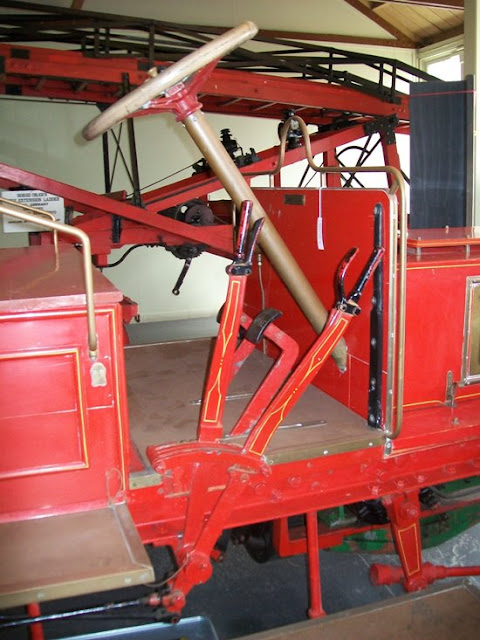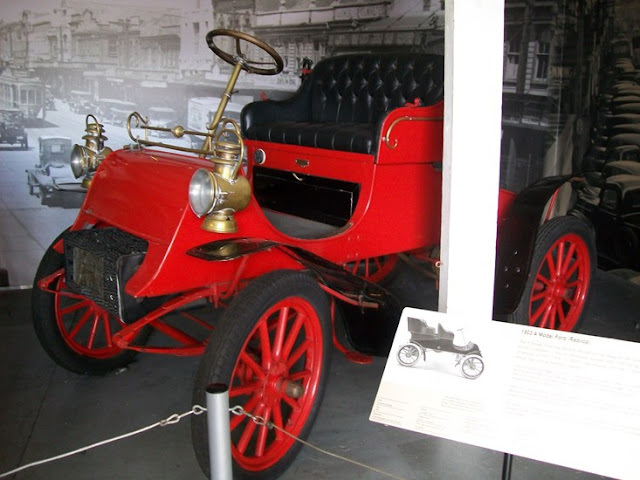On 1 April, MOTAT staged a day centred around things to do with fire. I went along for a bit of a look.
Newer versions of fire engines were up top, closest to the pumphouse, but that didn't really hold my interest. Thankfully, there was much more down the hill.
This truck in the line-up seems a bit confusing. In what way is this to do with fire equipment? I haven't identified it as yet (and there were no interpretive panels visible for it.)
Judging by the excellent site 111 Emergency, this is MOTAT's 1969 International C1800, used in Auckland.
1955 Dennis F8, also used in Auckland.
The makers started out as Dennis Brothers Limited back in 1895, according to Wikipedia, as bicycle makers in Guildford. Motor vehicles followed in 1899 (a motor-powered tricycle), buses by 1903, and fire engines by 1908. The company, after corporate takeovers from the 1970s, still exists and still makes fire engines.
Compare the 1937 Dennis Lance, used in Waverley and Whanganui, an English Dennis chassis with "New World" body added in Whanganui, according to the interpretive panel.
The engine in use in Whanganui (from the panel). The body style allowed firemen to sit facing inwards, rather than riding on the outside.
1971 Bedford KELC3, used in Murupara, Rotorua and Turangi (the latter still visible on the livery). Bedford is a subsidiary of Vauxhall Motors, which in turn stemmed from General Motors, which established the British subsidiary of the American firm in 1930. More on Bedford history here.
1956 Bedford A2, from Taihape.
Commer Karrier. Both Commer and Karrier makes are part of a tangled weave of corporate takeovers in their histories. Commer was a British manufacturer from 1905 to 1979, according to Wiki. They took over Karrier (which itself dated from 1904, a Yorkshire firm originally) from 1934, but today Karrier is owned by Peugeot. This example bears Auckland Metropolitan livery.
1905 Birmingham Small Arms bicycle replica, according to 111 Emergency. Another image here. The Birmingham Small Arms company began as gunsmiths from 1854. The company began the sideline of cycle manufacture in 1880. The company specialised in military-style bicycles, some of which folded up between uses -- but I haven't seen a bicycle before with a hose-carrying attachment. I'd like to know more.
Here (below), the cyclist (who very kindly posed for the image above) is next to some of the crew from the Auckland Fire Brigade Historical Society.
The historical society based themselves beside the 1971 International CO8190, labelled by MOTAT as a 1971 Darley International Snorkel. The snorkel bit apparently comes from the Hydraulic Elevating Platform, known as a snorkel. Cab was built by Cincinnati Cab Company (probably hence the American look), and the body by Apex Motor Bodies in Auckland. It served at Auckland and Manukau and was donated to MOTAT in 2002, according to its info panel.
On to the 1907 Merryweather fire engine.
This particular example served in the Sydney Metropolitan Fire Brigade (as in photo above, from the panel) before being imported in 1969 by a private individual. It was acquired by MOTAT in 1973, and at least one of those who helped to restore it was there on that Sunday I visited.
Merryweather & Sons, of Clapham and Greenwich, near London, was established back in 1692, making them probably the earliest in terms of manufacturing history of the appliances in MOTAT's collection. This engine's pump can't work with pressurised water mains, only from open water.
Then we have the 1868 Shand Mason Horse-drawn Manual Pump, originally known as "Excelsior" and used by the Reefton Volunteer Fire Brigade from 1869 all the way to 1937, according to the info panel. It was sold to Auckland Fire Board in 1939 for the 1940 Centennial celebrations. It was then supposed to head to Auckland Museum -- but headed north instead, to Wellsford Fire Brigade, who used it (!) until 1955. The panel says "It was their only fire engine, and was used during a major fire in the town in 1955, which it failed to contain."
The photo above, from the Alexander Turnbull Library (and the info panel), shows a similar horse-drawn fire engine in Petone.
Shand-Mason itself was founded as a manufacturer of fire pumps and engines in 1774. The firm's main competitor was the old Merryweather company, which eventually bought out Shand-Mason in 1922, according to Roger C Mardon's An Illustrated History of Fire Engines.
According to the info panel, this is supposed to be MOTAT's 1938 Ford V8 fire engine. But I did think that it was odd that the vehicle didn't quite match the photo on the panel (below), and seemed to have been modified since it was in use by the Auckland Fire Brigade.
I wrote initially: "Comparing the photo from the info panel with the engine today, the hand crank is still there, but higher up in a new grill. The side vents used to be vertical, but now configured horizontal. It looks like the whole front was changed at some point. It served at Devonport until 1974, and was nicknamed 'The Rattler'. It saw the introduction of pneumatic tires which allowed the fire engine to go faster than previous types, and the 'New World' body meant firemen no longer had to cling to the sides (as with the 1937 Dennis Lance, earlier in this post)."
Well, thanks to Stephen's comment a few hours later, we now have what appears to be an info panel which does not go with the vehicle displayed.
"The Fire engine shown in the pictures registered number EZ1894 is a 1940 Ford V8. It was still in service in the late 1970's based at the Mt Roskill Fire Station in Mt Albert Rd. The Fire engine in the black and white photo is a 1935 Ford V8 and was in ordinary service at Devonport until 1974 when it was donated to MOTAT. It was on display for awhile then disappeared as have several other early Ford V8 fire engines that Motat was given."
So, MOTAT? Please update your info panel, and correctly caption the historic image. Thanks.
This, according to the sign, is a "Horse-Drawn Fire Extension Ladder", built in Germany in 1893, with an extension of 75 feet, presented to MOTAT by the Auckland Metropolitan Fire Board. According to Mardon, two German manufacturers of fire ladder equipment at the time were Magirus-Deutz and Stahl and Honig.
Tucked away in a corner of the restoration shed -- W10, a Crown firecoach from the Los Angeles City Fire Department. Why this wasn't on display, I don't know. There's a vid of it in operation here.
The Crown Coach Corporation in the States also made the iconic yellow school buses we see in American telly shows and movies. They began in 1904 as the Crown Carriage Company, making buses until diversifying into fire engines from 1951 to 1985. The company was purchased by General Electric in 1985, and ceased production in 1991.
Now, the other stuff ... This appears to be a Lansing Bagnall horticultural truck. The company operated from 1943 to 1989, mainly known for forklifts.
Still working on identifying this ambulance under restoration, with the help of my friend Liz. Two further images of the vehicle are online at 111 Emergency: here, and here. From those, this appears to have originally come from Otahuhu, and it could be a Dodge, 1930s-1940s, but more info would be needed.
Update: Stephen, in the comments, has provided information -- and it isn't great news.
That is a pity.
Update: Stephen, in the comments, has provided information -- and it isn't great news.
"The ambulance referred to above is a pre-war International. It belonged to the Otahuhu Railway workshops. When the ambulance was retired the Otahuhu Railway workshops staff restored it to immaculate condtion then donated it to Motat. After a while Motat put it outdoors into the weeds by the Motions Rd entrance (along with several other desirable vehicles) where it deteriorated and meanwhile used indoor areas for irrelevant Disneyland type things.I last saw it in the weeds a number of years ago but at least it is now back under cover albeit a shadow of its former self."
That is a pity.
I sent around a "please help" for this to Liz and another friend, Bill Ellis. Bill came up with the exact make (because he said he's worked on them a fair bit over the years) -- 1952 Ford Prefect E493-A. Fairly well matches the example I found on Wiki. They were in production from 1949-1953, and were the second in the series of the Ford Prefect line.
I headed through part of the rest of MOTAT's buildings at one point -- and found something else tucked into a corner -- a G. Bacigalupo barrel organ from Berlin, Germany. The Bacigalupo family were apparently a force to be reckoned with in the barrel organ world. You can hear one here.
I was told, enthusiastically by one of the fire engine enthusiasts, that I had to see this, and he took me around to the next display -- a replica of a Ford A Model from 1903. This is the two-seater runabout version. The replica was purchased by MOTAT in 1978, with the assistance of the Ford Motor Company of New Zealand, celebrating Ford's 75th anniversary. There's a good image of it here without the surrounding clutter.
And this is the car the Ford later models surpassed: 1912 Liberty-Brush runabout. Wooden construction (yes, even the wheel spokes are wood!) couldn't compete with mass-produced steel -- Brushes were only produced from 1907 to 1913. When first sold, this car cost US$350, according to the info panel.
Alanson Partridge Brush founded the Brush Motor Car Company. According to Wiki:
A feature of engines designed by Brush (who also designed the first Oakland Motor Car, ancestor of Pontiac and who helped design the original one-cylinder Cadillac engine) was that they ran counter-clockwise instead of the usual clockwise, which, in those days before the invention of the electric starter, was Brush's idea intended to make them safer for a right-handed person to crank-start by hand. With clockwise-running engines, many injuries were sustained, most often dislocated thumbs and broken forearms, if the hand crank kicked back on starting, especially if the car was not properly adjusted before starting, or the person cranking it did not follow correct safety procedures, including fully retarding the manual spark advance, keeping the thumb alongside the fingers instead of around the crank, and pulling the crank upward in a half turn, never in a full circle or pushing down.
I do like the cheery livery of the Brush -- a good way to end the visit.




































































